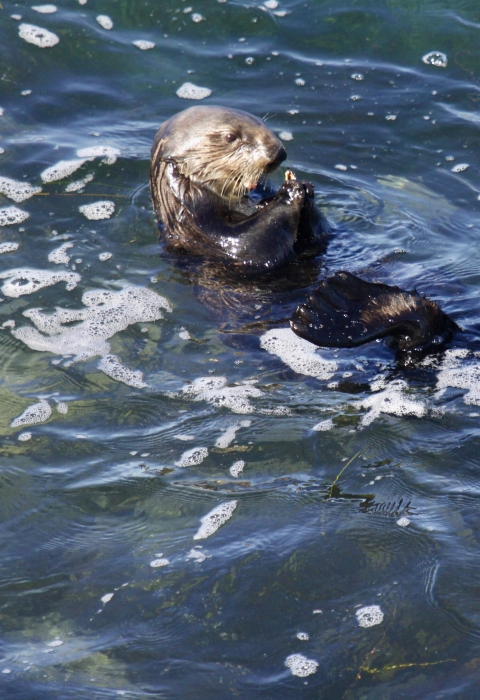Santa Cruz, Calif. - Recently, a female southern sea otter displaying highly unusual aggressive behavior with surfers and kayakers in Santa Cruz, California has attracted a lot of attention. Wildlife officials professionally trained in sea otter conservation and behavior continue to monitor the sea otter, however capture attempts have been unsuccessful. The decision to attempt capture was made for her own safety and the safety of humans recreating in the area. In the meantime we have seen a significant increase in human-caused disturbance to sea otters in Santa Cruz and other areas along the Central California coast, including jet skis and small watercraft getting far too close to resting sea otters.
Unfortunately, all that extra attention from the public could be harmful or even lethal to sea otters in the area.
“These reports of increased human-caused disturbance are alarming and could be fatal to the sea otters if the disturbance causes them to over-expend energy, especially mothers who need energy reserves to have the strength and stamina to feed and raise their young pups,” said Gena Bentall, Director of Sea Otter Savvy, an outreach and education program that educates community members, commercial tourism companies, and other ocean users about ethical sea otter viewing along the Central California coast. “Sea otters live each day paycheck to paycheck energetically. Human disturbance creates a deficit in their already taxed daily energy budget.”
“Sea otters face significant challenges in the wild, from shark bites to adapting to a changing climate, all while maintaining the energy to survive and raise their young. Additional unnecessary human-caused disturbance adds another threat to their already difficult life in the wild,” said Lilian Carswell, southern sea otter recovery and marine conservation coordinator with the U.S. Fish and Wildlife Service. “By maintaining a safe distance and giving them their space, you can help sea otters thrive in the wild.”
While getting up close and personal with a sea otter may seem adorable and harmless, it can cause harm and sets a bad example when it comes to how we interact with wildlife. Sharing photos and videos of close wildlife encounters causes further harm by encouraging others to seek out those interactions as well.
Getting too close can interfere with the animal’s ability to forage and get essential rest, ultimately affecting the animal’s overall health.
Why is resting so important for otters?
Not equipped with blubber like whales and seals, sea otters must rely on their fur coat and their super-high metabolic rate to stay warm. The average adult sea otter has to actively forage and eat 20 to 30 percent of its body mass in food each day just to meet its energy requirements. That's why it's incredibly important for sea otters to conserve their energy, and why they are often seen resting on their backs on the water's surface when they are not foraging—their survival depends on it.
We ask that everyone please adhere to the following guidelines for the safety of both people and southern sea otters
- Be alert: Be aware of your surroundings and alert to nearby wildlife when recreating.
- Maintain a safe distance: If a sea otter notices you, you are likely too close and should back away.
- Keep at least 60 ft. (or five kayak lengths) away, passing by parallel rather than pointing directly at any animals and moving slowly but steadily past rather than stopping.
- Slow down: Take caution in areas where sea otters are known to be present. Watercraft should slow down around kelp forests, where sea otters often rest but can be difficult to see. Be aware that a sea otter may come up from underwater unexpectedly.
- Keep pets leashed: Keep pets on a leash on and around docks and harbors, and never allow interactions, even if the animals appear to be playing. Look for a designated pet beach as an alternative.
- Never feed sea otters: Feeding otters can cause them to become aggressive which could result in their removal from the population and placement in an animal care facility.
Did you know?
Once ranging from Oregon to Baja California, Mexico, the southern sea otter was driven to the edge of extinction by hunting for the fur trade in the 1800s. After more than 100 years of protection, southern sea otters still occur only along the central California coast and at San Nicolas Island in southern California. Their nearshore habitat includes areas of high human activity, such as harbors.
Sea otters play a fundamental role in the ecological health of nearshore ecosystems. Their presence in the ocean enhances biodiversity, increases carbon sequestration by kelp and seagrass, and makes the ecosystem more resilient to the effects of climate change climate change
Climate change includes both global warming driven by human-induced emissions of greenhouse gases and the resulting large-scale shifts in weather patterns. Though there have been previous periods of climatic change, since the mid-20th century humans have had an unprecedented impact on Earth's climate system and caused change on a global scale.
Learn more about climate change .
Southern sea otters are listed as federally threatened under the Endangered Species Act. They are also protected under the Marine Mammal Protection Act and California state law. These laws prohibit harassing, hunting, capturing, or killing these animals. Approaching a sea otter so closely that it changes its behavior may constitute a violation of these laws and could result in penalties, including fines up to $100,000 and potential jail time up to one year.







